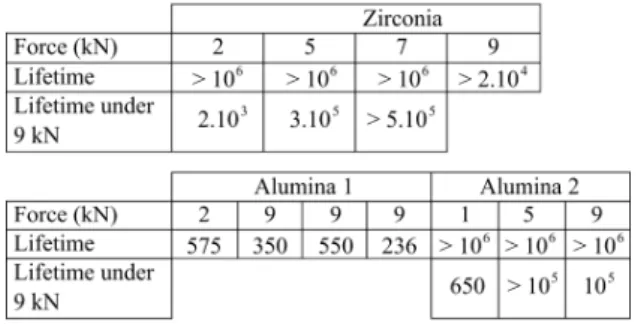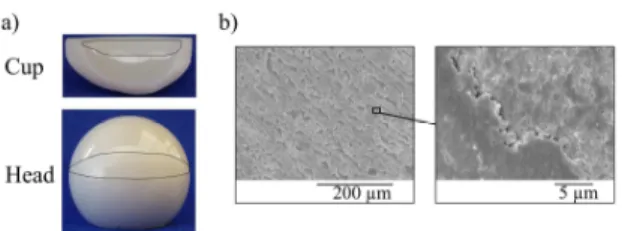HAL Id: hal-01063490
https://hal.archives-ouvertes.fr/hal-01063490
Submitted on 12 Sep 2014
HAL is a multi-disciplinary open access
archive for the deposit and dissemination of
sci-entific research documents, whether they are
pub-lished or not. The documents may come from
teaching and research institutions in France or
abroad, or from public or private research centers.
L’archive ouverte pluridisciplinaire HAL, est
destinée au dépôt et à la diffusion de documents
scientifiques de niveau recherche, publiés ou non,
émanant des établissements d’enseignement et de
recherche français ou étrangers, des laboratoires
publics ou privés.
Shock Induced Damages on alumina and zirconia hip
prostheses
J. Hausselle, Jean Geringer, M. Dursapt, Bernard Forest
To cite this version:
J. Hausselle, Jean Geringer, M. Dursapt, Bernard Forest. Shock Induced Damages on alumina and
zirconia hip prostheses. EUROMAT 2009, 2009, Glasgow, United Kingdom. p.3. �hal-01063490�
SHOCK INDUCED DAMAGES ON ALUMINA AND ZIRCONIA HIP
PROSTHESES
J. Hausselle1, J. Geringer1, M. Dursapt2, B. Forest1
1
CIS, Ecole Nationale Supérieure des Mines de Saint-Etienne, UMR CNRS 5146, IFR
INSERM 143, Saint-Etienne, France
2
LTDS, Ecole Nationale d’Ingénieurs de Saint-Etienne, UMR CNRS 5513, Saint-Etienne,
France
Introduction
Ceramics mostly used in orthopaedics are alumina (Al2O3) and zirconia (ZrO2), the rate of fracture
bioceramics hip prostheses being around 0.01% [1]. Some in vivo fractures have been reported and some of them have occurred in overweight patients [2]. One may suggest that prostheses may fail because of important repeated mechanical shocks. Moreover, the microseparation between the head and cup that may occur in vivo [3,4] seems to be another key parameter influencing the lifetime of the prostheses. Only few walking hip simulators have been modified to take into account this phenomenon and it has been shown that microseparation increases the wear and creates the so-called wear bands that have been observed in vivo on ceramic heads [5,6]. The main goal of this work was to use a specially designed shock machine to test bioceramics heads and cups under microseparation.
Materials and methods
Three types of head-cup couples were tested in this study, four in zirconia-zirconia, four in type 1 alumina and three in type 2 alumina-alumina, all of them following the ISO standards 13356 for zirconia and 6474-1 for alumina.
The shock machine used has been specifically designed and its ability of ruining prostheses by testing them under microseparation has already been demonstrated [7]. The orientation of the heads and cups was of 45° in the frontal plane and the impact force was applied vertically in 11 ms, whereas the shock frequency was set to 2 Hz. All the tests were carried out under dry condition, with a 1.3 mm microseparation and forces ranging from 1 to 9 kN. If after a million shocks none of the elements were broken, the test would be carried on with a force of 9 kN until the ruin of one of the elements or until reaching 105 shocks.
The worn areas and the fractures surfaces obtained have been observed using Scanning Electron Microscopy (SEM, JEOL 840 JSM). In addition, X Ray Diffraction apparatus (Siemens and specific detector [8]) was used to detect phase transformation on the zirconia heads.
Results
For all the prostheses tested, the cup has always been the element that broke first. The lifetimes obtained were very scattered (Table 1) and the four zirconia cups all broke in their superior region, whereas all the alumina cups broke in their inferior region. Some intragranular fractures have been observed for alumina, whereas only intergranular fractures have been observed in zirconia.
Table 1. Experimental parameters and lifetimes (number of shocks) obtained for zirconia and alumina cups.
Two wear bands have been observed on all the heads and cups tested, one in the superior part and another one in the inferior part (Fig. 1.a). Regardless of the bioceramics considered, the topography of the wear bands consists of a succession of highly worn areas and less worn ones, looking like wear “waves” (Fig. 1.b). Moreover, grains pull out sites have been observed near the wear bands and on the rim of the cup, where the impact took place.
Concerning zirconia, two types of debris have been found, some micrometrics ones, constituted of few grains, and some larger ones, up to few tens of micrometers. Concerning alumina, the same types of debris have been found, except that the larger ones look like plates.
DRX measures have shown the presence of monoclinic phase located in the wear band of zirconia heads, whereas mainly tetragonal phase has been detected everywhere else on the heads.
Figure 1: (a) Wear bands on the superior parts of a broken zirconia prosthesis (perimeters tainted in black for visualization). (b) SEM images of wear “waves” constituting the wear bands of the heads.
Discussion
The locations of the wear bands on the head and on the rim of the cup are similar to the ones found in previous in vitro and in vivo studies [5,6,8]. Moreover, these results demonstrated that wear bands may only be consequences of microseparation, shocks and eventually small sliding between the head and the cup. Indeed, in opposition with these previous studies, only the vertical force has been applied, and not the complete gait cycle, involving large rotations of the head in the cup.
Wear debris volume was more significant for zirconia than for alumina. As these debris may act as a third body and dissipate a part of the mechanical energy, reducing the number of surface microcrackings, this may explain the apparent slightly superior lifetimes of the zirconia cups with respect to the alumina ones. Wear can therefore enhance the shock resistance of prostheses, even if too much wear debris in vivo may also cause inflammatory reactions and lead to bone resorption [9].
It is believed [10] that, during the impact phase, isolated or aggregated grains are pulled out from the contact surfaces. Then, during potential rebonds of the head in the cup, debris are trapped between these two elements and may be accumulated in the surface flaws, leading to the wear “waves” observed, or act as a third body to dissipate energy. Surface flaws created in the wear band may become a preferential site where the fracture initiates and starts to propagate.
Concerning zirconia cups, the fractures all seem to have started on the side of the cup, near the rim. For the alumina cups, the precise locations of the initiation were more difficult to determine for sure, due to the presence of several fracture parts. The different lifetimes obtained for the two types of alumina can be explained by the differences of microstructures. Observing fracture surfaces, it has been found that grains sizes are more inhomogeneous for alumina 1 than for alumina 2. Moreover, alumina 1 exhibited more intergranular porosities. These observations are consistent with
the known fact that microstructures greatly influence the toughness of ceramics.
Finally, one may suggest that mechanisms concerning zirconia and alumina failures are rather different under shock damages, according to the findings of this study. Figure 2 presents these two mechanisms. Microseparation and shocks induce a grains pull out phenomena for zirconia. Under repeated shocks, grains are compacted to build a third body acting as a compressive layer to dissipate mechanical energy. Concerning alumina, microseparation and shocks induce crack propagation in the bulk material. When two cracks merge, under the surface of the material, it creates plates, constituted of few tens of grains.
Figure 2: Fracture mechanisms under shocks degradations for zirconia (a) and alumina (b).
Conclusion
With the use of a novel shock machine and the introduction of microseparation between the head and the cup, wear bands appeared after only few thousands cycles, leading to the fracture of the cups. It has been hypothesized that the surface flaws created inside the wear bands may be considered as potential initiation points of the fracture. Moreover, two different wear mechanisms, plates for alumina and grains for zirconia have been proposed and need confirmation in future works.
Acknowledgements
The authors would like to acknowledge the Rhône-Alpes Region for its financial support and the industrial partners, HTI Technologies and SERF, for providing the bioceramics prostheses.
References
[1] Weisse B. Improvement of the reliability of ceramic hip joint implants. J Biomech 2003; 1633:1639.
[2] Michaud RJ. Spontaneous fracture of the ceramic ball in a ceramic-polyethylene total hip arthroplasty. J Arthroplasty 1995; 863:867.
[3] Dennis DA. In vivo determination of hip joint separation and the forces generated due to impact loading conditions. J Biomech 2001; 623:629.
[4] Lombardi J. An in vivo determination of total hip arthroplasty pistoning during activity. J Arthroplasty 2000; 702:709.
[5] Stewart TD. Long-term wear of ceramic materials composite materials for hip prostheses under severe swing phase microseparation. Journal of British Medical Research 2003; 562:573. [6] Walter W. Edge loading in third generation alumina ceramic-on-ceramic bearings, J Arthroplasty 2004; 402:413.
[7] Hausselle J. Shock induced damages on hip prostheses. Presented at the 20th European Conference on Biomaterials. September 2006; European Society of Biomaterials; Nantes, France. [8] Fillit R. Phase analysis apparatus by X-ray diffraction on textured or non-textured sample using an electronic photodetector. European patent, n°0161992, 1987.
[9] Kubo T. Histiocyte reaction in rabbit femurs to UHMWPE, metal, and ceramics particles in different sizes. J Biomed Mater Res 1999; 363:369.
[10] Hausselle J. Etude de la dégradation par chocs de têtes et cupules de prothèses de hanche en biocéramique. Ph. D. Thesis 2007, n° 458 SGM. Ecole Nationale Supérieure des Mines de Saint-Etienne, France.

